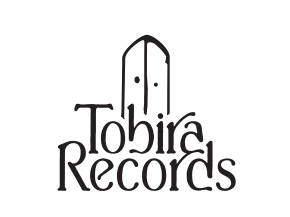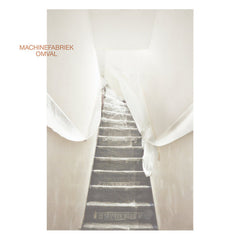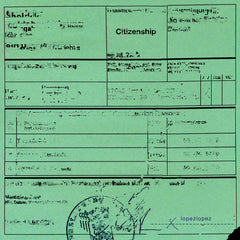Raoul van Herpen // Italian Division CD
- Availability:
オランダの実験音楽家Raoul van Herpenが、2021年7月にアメリカのノイズレーベルFlag Dayからリリースした、イタリアンアヴァンギャルドをコンセプトにしたアルバム。デジパック、シュリンク仕様です。以下、作家本人による解説です。
"これらの作品を作曲する際、私は20世紀と21世紀の作曲技法に着目し、主に3つのコンセプトで作曲を行いました。シリアリズム、マイクロトナーリティ、ノイズです。前世紀のイタリアンアヴァンギャルドは、ノイズ、ニューミュージック、ピサのレオナルド(後にフィボナッチとして知られる)の数学など、すべてを備えていたと言ってもよいでしょう。
Composition For Two Oscillators And Two Tape-Recorders "を作るにあたって、私は微分音に注目しました。私が好きで、遊んでいる基本的なコンセプトは、音が近づき、互いに影響し合い始めると、音はほとんどそれ自体で動き出すというものです。そうすると、演奏していないのに美しい音色やハーモニクスが発生し、作品が生き物のように見えてきます。微分音程で動く音は、この作品をより細やかに、ほとんど気づかないほどの動きにしている。これは、2台のテープレコーダーが、大きくゆっくりとしたテープディレイとして機能するように配置されていることが、すべての効果を高めている。2台のテープレコーダーの間に距離があるため、ピッチがずれ、これが再びレコーダーにフィードバックされ、再び音色が聞こえ、そのたびにどんどんドリフトしていく。一方、2つの発振器もレコーダーに入力し続ける。その結果、常に進化し続けることになる。非常に激しい試聴だが、それをやってみると、音色やハーモニクスやレイヤーの素晴らしい世界に入り込むことはもちろん、平和な感覚やトランス状態になる。
「Eert Uw Vader En Uw Moeder "はもともと聖書のテキスト "Honor Thy Father And Thy Mother "の古いモンゴル語の録音です(と書いてありますが、私のモンゴル語はかなり下手です...)ここで私は音と沈黙の間隔とそれがメッセージに与える芝居の効果で遊びました。オルガンの和音は、実はエレクトリック・ウーリッツァー・ピアノによるものです。
先にも述べたように、私は作曲においてシリアリズムが好きです。「Hooray For Today」は、前世紀の直列的な「コラージュ」のような作曲を思い起こさせます。音の有無、ノイズやサイレンス、遠景や近景、演奏時間、エフェクト、音のレイヤー、などなど、ほとんどのパラメータがシリアリズムによって構成されています。これはすべて、私がもらった、大きさの異なるドットが描かれた線で埋め尽くされたバースデーカードから導き出されたものです。実際には、すべての線に異なるパラメータを与え、すべてのドットがそのパラメータの異なる設定を意味するようにしました。
一方、「イタリアンディビジョンズ」は、もう少し複雑でした。土台は2つのパートからなり、まず5つの異なるノイズソースがあり、それぞれ異なる処理と演算が施されています。フィボナッチ数列を使って、それを音と静寂に分割し、構造化することができました。その後、様々なツールを使ってすべてのノイズを収縮、拡張、粒状化し、美しいノイズ、亀裂、あらゆる方向の音に満ちた作品へと構築していきました。注意深く聴くと、パート1は空間について、パート2はグルーヴを閉じ込め、パート3はハーモニーとメロディーを包含しているとさえ言えるでしょう。"
レーベルその他作品はこちら /// Click here to see more Flag Day Recordings releases available at Tobira.
----------------------------
Text by Flag Day Recordings:
"While composing these pieces, I focused on the 20th and 21st-century composition techniques in three main concepts: Serialism, Microtonality, and Noise. You could almost say the Italian Avant-garde of the last century had it all: noise, new music, and the math of Leonardo of Pisa, later known as Fibonacci.
In making "Composition For Two Oscillators And Two Tape-Recorders" I focused on microtonality. The basic concept I like and play with is when tones get close and start to interact with each other, they happen to move almost by themselves. Like this, beautiful tones and harmonics seem to occur that aren't even played and the piece becomes a living creature. Tones moving in microtonal steps makes this work with more detail and almost imperceptible movement. This is all enhanced by the two tape-recorders placed in a way so they work as a big and slow tape delay unit. Because of the distance between the two recorders the pitch shifts, this is again fed back into the recorder to hear the tone again, and again each time drifting more and more. Meanwhile, the two oscillators keep playing into the recorders too. This results in an ever-ongoing and evolving process. It is a very intense listen but when you go for it, you get a sense of peace and a state of trance, let alone the wonderful world of timbre and harmonics and layers you enter.
"Eert Uw Vader En Uw Moeder" is originally an old Mongolian recording of the biblical text "Honor Thy Father And Thy Mother" (so it says, my Mongolian is pretty bad..) Here I played with the spacing of sound and silence and the theatrical effect this gives to the message. A fun little detail, the organ chords are, in fact, from an electric Wurlitzer Piano.
As I mentioned, I love serialism in my compositions. "Hooray For Today" reminds me of the serial "collage" like compositions of the last century. Most of the parameters are configured by serialism, like, whether there is sound, noise or silence, far away or close by, play lengths, effects, one or multiple layers of sound, etc. This is all derived from a birthday card I got, that is filled with lines with different sized dots on it. In practice, I gave every line a different parameter where every dot means a different configuration of that parameter.
The "Italian Division's" on the other hand was a bit more complex. The foundation consists of two parts starting with 5 different noise sources which all had different handlings and operations. Using the Fibonacci sequence I was able to divide and structure it into sound and/or silence. Building onwards by using different tools to contract, expand and granulate all the noises to a piece full of beautiful noise, cracks, and sounds in every direction. If you listen carefully, you could even say that part 1 is about space, part 2 locks in grooves and part 3 embraces harmony and melody."
Artist : Raoul van Herpen
Label : Flag Day Recordings
オランダの実験音楽家Raoul van Herpenが、2021年7月にアメリカのノイズレーベルFlag Dayからリリースした、イタリアンアヴァンギャルドをコンセプトにしたアルバム。デジパック、シュリンク仕様です。以下、作家本人による解説です。
"これらの作品を作曲する際、私は20世紀と21世紀の作曲技法に着目し、主に3つのコンセプトで作曲を行いました。シリアリズム、マイクロトナーリティ、ノイズです。前世紀のイタリアンアヴァンギャルドは、ノイズ、ニューミュージック、ピサのレオナルド(後にフィボナッチとして知られる)の数学など、すべてを備えていたと言ってもよいでしょう。
Composition For Two Oscillators And Two Tape-Recorders "を作るにあたって、私は微分音に注目しました。私が好きで、遊んでいる基本的なコンセプトは、音が近づき、互いに影響し合い始めると、音はほとんどそれ自体で動き出すというものです。そうすると、演奏していないのに美しい音色やハーモニクスが発生し、作品が生き物のように見えてきます。微分音程で動く音は、この作品をより細やかに、ほとんど気づかないほどの動きにしている。これは、2台のテープレコーダーが、大きくゆっくりとしたテープディレイとして機能するように配置されていることが、すべての効果を高めている。2台のテープレコーダーの間に距離があるため、ピッチがずれ、これが再びレコーダーにフィードバックされ、再び音色が聞こえ、そのたびにどんどんドリフトしていく。一方、2つの発振器もレコーダーに入力し続ける。その結果、常に進化し続けることになる。非常に激しい試聴だが、それをやってみると、音色やハーモニクスやレイヤーの素晴らしい世界に入り込むことはもちろん、平和な感覚やトランス状態になる。
「Eert Uw Vader En Uw Moeder "はもともと聖書のテキスト "Honor Thy Father And Thy Mother "の古いモンゴル語の録音です(と書いてありますが、私のモンゴル語はかなり下手です...)ここで私は音と沈黙の間隔とそれがメッセージに与える芝居の効果で遊びました。オルガンの和音は、実はエレクトリック・ウーリッツァー・ピアノによるものです。
先にも述べたように、私は作曲においてシリアリズムが好きです。「Hooray For Today」は、前世紀の直列的な「コラージュ」のような作曲を思い起こさせます。音の有無、ノイズやサイレンス、遠景や近景、演奏時間、エフェクト、音のレイヤー、などなど、ほとんどのパラメータがシリアリズムによって構成されています。これはすべて、私がもらった、大きさの異なるドットが描かれた線で埋め尽くされたバースデーカードから導き出されたものです。実際には、すべての線に異なるパラメータを与え、すべてのドットがそのパラメータの異なる設定を意味するようにしました。
一方、「イタリアンディビジョンズ」は、もう少し複雑でした。土台は2つのパートからなり、まず5つの異なるノイズソースがあり、それぞれ異なる処理と演算が施されています。フィボナッチ数列を使って、それを音と静寂に分割し、構造化することができました。その後、様々なツールを使ってすべてのノイズを収縮、拡張、粒状化し、美しいノイズ、亀裂、あらゆる方向の音に満ちた作品へと構築していきました。注意深く聴くと、パート1は空間について、パート2はグルーヴを閉じ込め、パート3はハーモニーとメロディーを包含しているとさえ言えるでしょう。"
レーベルその他作品はこちら /// Click here to see more Flag Day Recordings releases available at Tobira.
----------------------------
Text by Flag Day Recordings:
"While composing these pieces, I focused on the 20th and 21st-century composition techniques in three main concepts: Serialism, Microtonality, and Noise. You could almost say the Italian Avant-garde of the last century had it all: noise, new music, and the math of Leonardo of Pisa, later known as Fibonacci.
In making "Composition For Two Oscillators And Two Tape-Recorders" I focused on microtonality. The basic concept I like and play with is when tones get close and start to interact with each other, they happen to move almost by themselves. Like this, beautiful tones and harmonics seem to occur that aren't even played and the piece becomes a living creature. Tones moving in microtonal steps makes this work with more detail and almost imperceptible movement. This is all enhanced by the two tape-recorders placed in a way so they work as a big and slow tape delay unit. Because of the distance between the two recorders the pitch shifts, this is again fed back into the recorder to hear the tone again, and again each time drifting more and more. Meanwhile, the two oscillators keep playing into the recorders too. This results in an ever-ongoing and evolving process. It is a very intense listen but when you go for it, you get a sense of peace and a state of trance, let alone the wonderful world of timbre and harmonics and layers you enter.
"Eert Uw Vader En Uw Moeder" is originally an old Mongolian recording of the biblical text "Honor Thy Father And Thy Mother" (so it says, my Mongolian is pretty bad..) Here I played with the spacing of sound and silence and the theatrical effect this gives to the message. A fun little detail, the organ chords are, in fact, from an electric Wurlitzer Piano.
As I mentioned, I love serialism in my compositions. "Hooray For Today" reminds me of the serial "collage" like compositions of the last century. Most of the parameters are configured by serialism, like, whether there is sound, noise or silence, far away or close by, play lengths, effects, one or multiple layers of sound, etc. This is all derived from a birthday card I got, that is filled with lines with different sized dots on it. In practice, I gave every line a different parameter where every dot means a different configuration of that parameter.
The "Italian Division's" on the other hand was a bit more complex. The foundation consists of two parts starting with 5 different noise sources which all had different handlings and operations. Using the Fibonacci sequence I was able to divide and structure it into sound and/or silence. Building onwards by using different tools to contract, expand and granulate all the noises to a piece full of beautiful noise, cracks, and sounds in every direction. If you listen carefully, you could even say that part 1 is about space, part 2 locks in grooves and part 3 embraces harmony and melody."
Artist : Raoul van Herpen
Label : Flag Day Recordings







